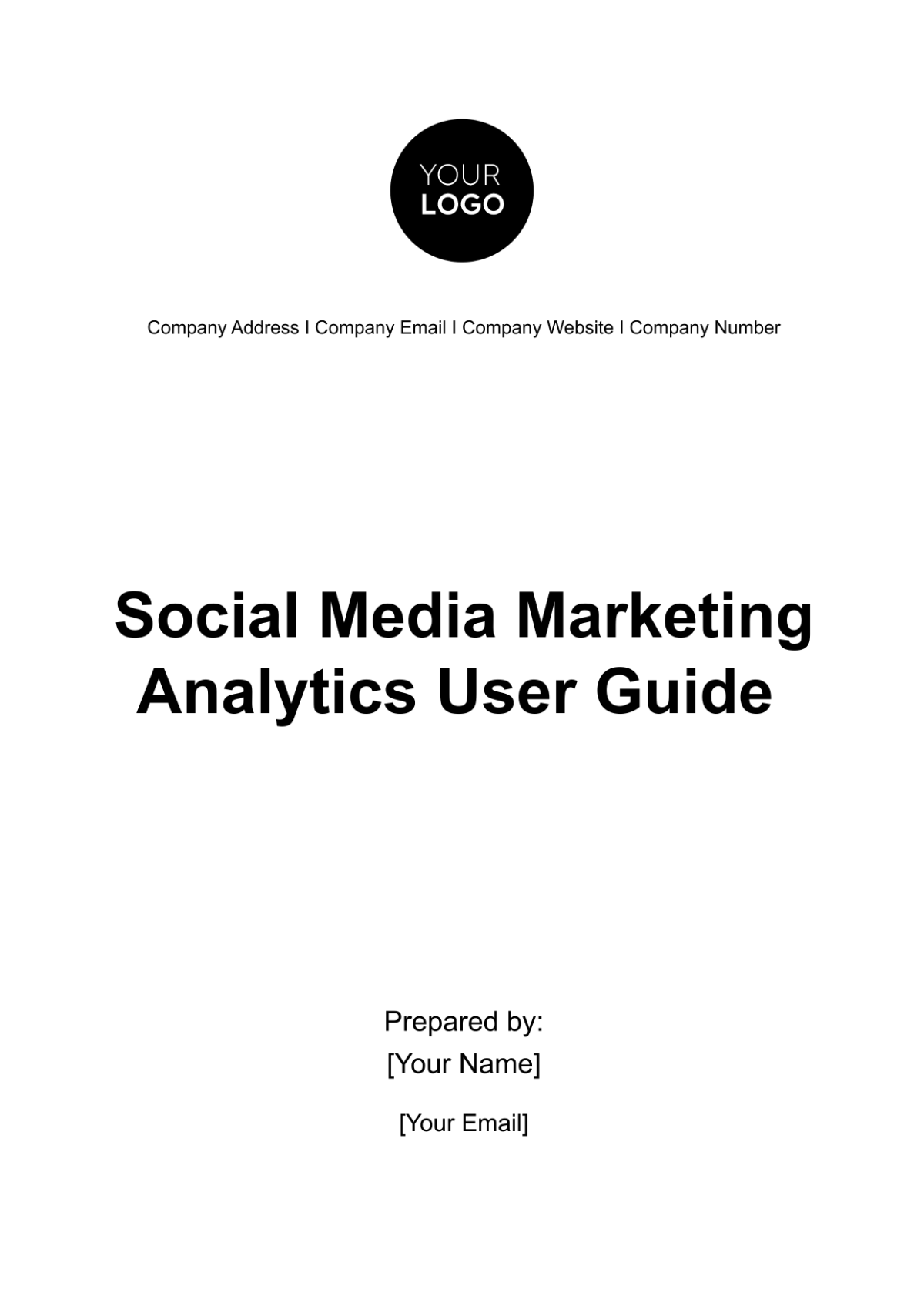Free Social Media Marketing Analytics User Guide

User Guide
Prepared by: [Your Name] Guide Version: 1.0
I. INTRODUCTION
A. Purpose of this User Guide
This user guide has been meticulously crafted to empower individuals and teams across diverse industries with the knowledge and skills needed to harness the full potential of social media marketing analytics. In the dynamic and ever-evolving landscape of digital marketing, understanding and utilizing analytics effectively is not just a competitive advantage; it's a necessity.
With this user guide, we aim to demystify the world of social media marketing analytics and provide you with actionable insights and strategies that will enable you to make data-driven decisions, optimize your social media strategies, and ultimately achieve remarkable results. Whether you are a seasoned marketing professional or just embarking on your social media journey, this guide will serve as a valuable resource.
B.Target Audience
This user guide is designed for professionals and teams operating in a wide array of business sectors, ranging from retail and finance to healthcare and technology. The principles and techniques covered here are universally applicable, ensuring that businesses of all types can harness the power of social media marketing analytics.
For those who are new to the world of analytics, this guide offers a comprehensive introduction, while experienced marketers will find advanced strategies and insights to further enhance their analytics capabilities. Regardless of your level of expertise, this guide aims to equip you with the tools and knowledge needed to succeed in the complex and data-rich realm of social media marketing.
C. Scope
The scope of this user guide covers everything from the fundamentals of understanding and accessing social media analytics platforms to advanced techniques like predictive analytics for campaign planning. Our goal is to provide you with a holistic understanding of how to utilize social media marketing analytics to your advantage.
II. UNDERSTANDING SOCIAL MEDIA ANALYTICS
A. What are Social Media Marketing Analytics?
Social media marketing analytics encompasses the systematic collection, analysis, and interpretation of data derived from social media platforms. It serves as the compass guiding your digital marketing efforts by providing invaluable insights into how your audience engages with your content, the effectiveness of your campaigns, and the overall impact on your business goals.
These analytics encompass a wide range of metrics, from the basic likes and shares to more complex conversion rates and competitive analysis. They provide a window into the minds and behaviors of your audience, enabling you to make informed decisions and tailor your strategies for maximum impact.
B. Why are Social Media Marketing Analytics Important?
In today's hyper-connected digital landscape, social media marketing analytics are nothing short of essential. They play a pivotal role in ensuring the success and longevity of your social media marketing efforts. Here's why they are indispensable:
Data-Driven Decision-Making: Analytics provide the data necessary to make informed decisions, reducing guesswork and increasing the chances of success.
Understanding Audience Behavior: With analytics, you can gain deep insights into your audience's preferences, behaviors, and demographics, allowing you to create content that resonates.
Campaign Optimization: By measuring the performance of your campaigns, you can optimize them in real time, ensuring that you get the best possible return on your investment.
Competitive Edge: Analytics enable you to benchmark your performance against competitors, identify gaps, and capitalize on opportunities.
Staying Agile: Rapid changes in the digital landscape require agility. Analytics help you adapt to algorithm changes and emerging trends promptly.
III. ACCESSING ANALYTICS PLATFORMS
A. Platform Overview
Understanding the landscape of social media analytics platforms is crucial for harnessing the power of data-driven decision-making. Each platform offers unique insights and tools tailored to its specific audience and features. Here's an overview of some popular social media analytics platforms:
ANALYTICS PLATFORM | DESCRIPTION |
Facebook Insights | Facebook's built-in analytics tool provides comprehensive data on page performance, audience demographics, and engagement metrics. It's an essential resource for businesses with a significant Facebook presence. |
Twitter Analytics | Twitter offers a dedicated analytics dashboard that tracks tweet performance, audience growth, and engagement trends. It's invaluable for businesses looking to optimize their Twitter strategies. |
Instagram Insights | For visual content marketers, Instagram Insights provides data on post reach, impressions, and audience demographics. It's ideal for businesses with a strong presence on Instagram. |
LinkedIn Analytics | LinkedIn's analytics platform offers insights into the performance of your company page, content engagement, and follower demographics. It's a must for B2B marketers and professionals. |
YouTube Analytics | Video content creators benefit from YouTube Analytics, which offers detailed information on video views, watch time, and subscriber growth. It's essential for businesses with a YouTube channel. |
Google Analytics | While not exclusive to social media, Google Analytics provides valuable data on website traffic, including traffic sources from social media platforms. It's crucial for understanding how social media impacts your website's performance. |
B. Account Setup
Setting up your analytics accounts is the first step toward data collection and analysis. Depending on the platform, you may need to follow specific steps to connect your social media accounts to their respective analytics tools. Account setup typically involves:
Verifying ownership of your social media accounts.
Granting necessary permissions to access analytics data.
Setting up tracking codes or tags (e.g., Facebook Pixel) for website integration.
Ensure that you have admin or manager access to your social media accounts to make the setup process seamless.
C. Navigating the Dashboard
Once your accounts are connected, navigating the analytics dashboard is essential to access and interpret data effectively. The dashboard layout may vary across platforms, but common elements include:
Overview: A summary of key metrics, often presented in graphs and charts.
Reports: Detailed reports on engagement, audience demographics, and performance.
Customization: Options to create custom reports, set date ranges, and apply filters.
Exporting Data: Tools to export data for further analysis or reporting.
Help and Support: Access to resources or support for troubleshooting issues.
IV. INTERPRETING KEY METRICS
A. Engagement Metrics
Engagement metrics are critical for understanding how your audience interacts with your social media content. Here's a deeper dive into key engagement metrics:
KEY ENGAGEMENT METRIC | DESCRIPTION |
Likes | The number of users who have liked your posts. High like counts indicate content resonance. |
Shares | The number of times users have shared your content. Shares amplify your reach and show audience advocacy. |
Comments | Comments represent direct engagement with your content. They provide valuable feedback and spark conversations. |
Click-Through Rate (CTR) | CTR measures the percentage of users who clicked on a link in your post. A high CTR indicates effective call-to-action strategies. |
Engagement Rate | This is a composite metric that combines likes, shares, and comments to assess overall engagement. It provides a holistic view of content performance. |
B. Audience Metrics
Understanding your audience is fundamental to tailoring your content and marketing strategies. Key audience metrics include:
Demographics: Insights into your audience's age, gender, location, and language preferences. Use this data to create targeted content.
Audience Growth: Monitor changes in your follower count and understand what drives growth or attrition.
Interests and Behavior: Learn about your audience's interests, preferences, and online behavior. This information helps you create content that resonates.
Follower Demographics: For platforms like Twitter and Instagram, see which demographics make up your follower base, helping you refine your content strategy.
Audience Segmentation: Group your audience into segments based on various criteria. This enables highly targeted campaigns.
C. Conversion Metrics
Conversion metrics are essential for measuring the impact of your social media marketing efforts on your business objectives:
Click-Through Rate (CTR): In addition to engagement CTR, monitor CTR for specific conversion goals, such as driving traffic to your website or landing pages.
Conversion Rate: Measure the percentage of visitors who complete a desired action, like making a purchase or signing up for a newsletter, after clicking on a social media link.
Revenue Generated: Track the actual revenue generated from social media campaigns. This metric provides a clear ROI assessment.
Lead Generation: If lead generation is a goal, analyze how many social media visitors become leads through sign-up forms or contact inquiries.
Attribution Modeling: Understand how different touchpoints (e.g., social media, email, website) contribute to conversions through attribution models.
D. Competitive Analysis
Benchmarking your performance against competitors is a valuable exercise to identify strengths and weaknesses. Here's how to approach competitive analysis:
Competitor Metrics: Research and compare key metrics like engagement rates, audience growth, and content strategies with your competitors.
Content Analysis: Study your competitors' top-performing content and identify patterns or themes that resonate with their audiences.
Audience Overlap: Discover how much overlap exists between your audience and your competitors'. Target shared audience segments for growth.
Emerging Trends: Stay updated on industry trends and see how your competitors adapt their strategies to capitalize on them.
Differentiation: Use competitive analysis to find opportunities for differentiation and innovation in your social media marketing.
V. USING ANALYTICS FOR DECISION-MAKING
A. Setting Goals and Objectives
Setting clear and achievable goals and objectives is the foundation of a successful social media marketing strategy. Analytics play a pivotal role in helping you measure your progress towards these goals and make informed decisions. Here's how to utilize analytics effectively:
Define Specific Goals:
Clearly define what you want to achieve through your social media marketing efforts. Are you looking to increase brand awareness, drive website traffic, boost sales, or enhance customer engagement? Specific goals ensure that your strategy remains focused and measurable.
Set Key Performance Indicators (KPIs):
Once your goals are defined, identify relevant KPIs. For example, if your goal is to increase website traffic, KPIs might include click-through rates (CTR), traffic sources, and the number of conversions generated through social media.
Monitor Progress:
Regularly track your KPIs using analytics tools. Pay attention to trends and anomalies. Are certain types of content performing better than others? Are there specific times or days when your audience is most engaged? Use this data to refine your strategy.
Adjust Strategies:
Analytics provide real-time insights that allow you to adapt your strategies. If a particular campaign isn't performing as expected, you can make adjustments on the fly. For instance, if engagement is low, consider modifying your content or posting schedule.
B. Benchmarking and Performance Tracking
Benchmarking involves comparing your social media performance against industry standards and competitors. This helps you identify areas for improvement and innovation:
Competitive Analysis:
Use analytics tools to track the social media performance of your competitors. Compare metrics like follower growth, engagement rates, and content strategies. Analyze what's working for them and consider applying similar strategies to stay competitive.
Industry Benchmarks:
Research industry benchmarks to understand how your metrics compare to the broader industry. This context helps you assess whether your social media efforts are above, below, or on par with industry standards.
Tracking Trends:
Analytics can help you spot emerging trends in your industry or niche. Stay vigilant for changes in audience behavior, platform algorithms, or content preferences. Adapting to these trends can give you a competitive edge.
Data-Driven Content Strategy
Your content strategy should be informed by data. Analytics can guide your content creation and distribution in the following ways:
Content Performance Analysis:
Regularly analyze the performance of your content. Identify the types of content that resonate most with your audience. Are videos more popular than images? Do how-to guides perform better than product showcases? Tailor your content strategy accordingly.
Content Calendar Optimization:
Use analytics to determine the best times and days to post content. Consider factors like when your audience is most active and when engagement rates are highest. A well-optimized content calendar can maximize your reach and impact.
A/B Testing:
Experiment with different content variations and measure their performance. A/B testing allows you to refine your content strategy by comparing the effectiveness of different headlines, visuals, or calls to action.
VI. ADVANCED ANALYTICS TECHNIQUES
A. Custom Reports and Dashboards
Custom reports and dashboards allow you to tailor analytics to your specific business needs. Here's how to make the most of these advanced analytics features:
Report Customization:
Create custom reports that focus on the KPIs and metrics most relevant to your business goals. Highlight the data that provides actionable insights for your team.
Dashboard Creation:
Build custom dashboards that consolidate data from multiple sources and platforms. This centralizes your analytics, making it easier to monitor and compare performance across channels.
Automated Reporting:
Leverage automated reporting tools to save time and ensure that key stakeholders receive regular updates on social media performance. Automation ensures that you stay informed without manual data gathering.
B. Predictive Analytics for Campaign Planning
Predictive analytics uses historical data and machine learning algorithms to forecast future trends and outcomes. Here's how you can apply predictive analytics to your social media marketing:
Data Collection and Preparation:
Gather historical social media data, including engagement metrics, audience demographics, and campaign performance. Clean and prepare this data for analysis.
Machine Learning Models:
Utilize machine learning models to predict future trends, such as audience growth, engagement rates, or conversion rates. These models can help you make data-driven decisions in campaign planning.
Content Recommendations:
Predictive analytics can suggest content types, posting times, and messaging that are likely to resonate with your audience, increasing the effectiveness of your campaigns.
Optimization Iterations:
Continuously refine your predictive models based on real-time data. As you gather more data, your predictions become increasingly accurate, allowing for agile campaign optimization.
VII. CONCLUSION
A. Final Thoughts
Social media marketing analytics is an ever-evolving field that empowers businesses to make data-driven decisions. By following the best practices outlined in this user guide and staying informed about algorithm changes, you're well-prepared to navigate the complexities of the digital landscape.
Social media analytics isn't just about numbers; it's about understanding your audience, refining your strategies, and ultimately achieving your business goals. Continuously learning and adapting will help you thrive in the dynamic world of social media marketing.
B. Acknowledgments
We extend our appreciation to you for your commitment to mastering social media marketing analytics. As you apply these insights and techniques, we wish you success in leveraging analytics to enhance your social media marketing endeavors. Stay curious, stay data-driven, and stay ahead in the digital realm!
© 2050 [Your Company Name]. All rights reserved.
- 100% Customizable, free editor
- Access 1 Million+ Templates, photo’s & graphics
- Download or share as a template
- Click and replace photos, graphics, text, backgrounds
- Resize, crop, AI write & more
- Access advanced editor
Empower your social media marketing analytics with the Social Media Marketing Analytics User Guide Template, exclusively from Template.net. This editable and customizable resource offers comprehensive insights for professionals. Craft tailored user guides effortlessly using our Ai Editor Tool, ensuring effective data interpretation and strategy formulation. Elevate your analytics game and drive success in your marketing endeavors.
You may also like
- Instagram Ad
- Instagram Banner
- Instagram Frame
- Instagram Post
- Instagram Profile Picture
- Instagram Story
- Instagram Story Highlights
- Twitter Ad
- Twitter Header
- Twitter Post
- LinkedIn Photo
- Linkedin Post
- YouTube
- Youtube Ad
- Youtube Banner
- YouTube Channel Art
- YouTube End Screen
- Youtube Profile Photo
- YouTube Thumbnail
- Facebook Ad
- Facebook Cover
- Facebook Post
- Facebook Profile Frame
- Facebook Profile Photo
- Twitch Offline Banner
- Linkedin Banner
- Twitch Overlay
- Whatsapp Status
- Reddit Banner
- Social Media Banner
- Social Media Clipart
- Social Media Plan
- Social Media Contract
- Social Media Planner
- Social Media Report
- Social Media Agreement
- Social Media Business Card
- Social Media Proposal
- Social Media Presentation





























